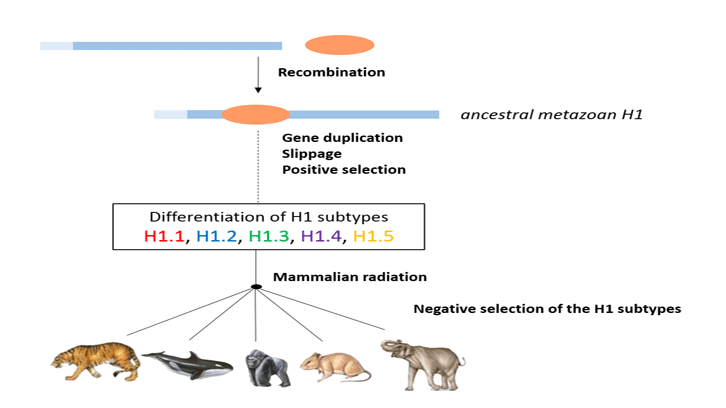Evolutionary history of the family of H1.1-H1.5 histones of mammals

In eukaryotes the chromatin is formed by a complex of DNA and proteins, mainly histones. Chromatin allows the compaction of the entire genome within the small nuclear volume. The nucleosome, the fundamental unit of chromatin, consists of an octamer of histones H2A, H2B, H3 and H4, DNA and histone H1. H1 is involved in the regulation of chromatin compaction and gene expression.
Histone H1 has a tripartite structure. The central domain (G) is stably folded, while the N- and C-terminal domains are intrinsically disordered, but folded when bound to DNA. In mammals, there are 7 somatic subtypes, H1.1-H1.5, H1.0 and H1x. The H1.1-H1.5 genes are located together in the genome and increase their synthesis rate during the S phase of the cell cycle. The central domain of the protein is virtually identical, while the terminal domains are more divergent and have different lengths. Although all H1 subtypes are able to bind and compact chromatin, there is evidence that suggests their functional differentiation.
Our research group has studied the molecular evolution of H1.1-H1.5 subtypes in mammals. Analysis of the alignment of 130 sequences from 27 different species showed that the number and position of the basic residues are highly conserved in all subtypes. Conservation of the high positive net charge is essential for the interaction of H1 with DNA. It is also apparent the conservation of many post-translationally modified positions, especially the phosphorylation sites.
We have found the presence of a pattern of insertions/deletions (indels) in the terminal domains among subtypes. The conservation of this pattern indicates that is ancestral to the division of mammalian orders. The terminal domains are encoded by sequences containing repeats, in which replication errors (slippage) are frequent favoring short insertions and deletions. This molecular mechanism would explain the rapid evolution of the terminal domains of H1 subtypes. The strong negative selection of the indels pattern indicates that it is associated with the functional differentiation of the subtypes.
The analysis with tools of molecular evolution has shown evidences of positive or adaptive selection in seven positions of H1.1, which are located in the 3 structural domains. The changes found in H1.1 include a decrease in the positive net charge, a decrease in the stability of the folding of the globular domain and a possible modulation of the folding of the C-terminal domain. Therefore, positive selection in H1.1 may be associated with a decrease in its affinity for chromatin, which would represent an adaptation of this subtype to its specific function, related to processes with relaxed chromatin states (replication and spermatogenesis).
We have detected possible recombination breakpoints between the terminal domains and the globular domain, which together with evidences described by other groups, suggests that this process may have been involved in the acquisition of the tripartite structure of H1. Integrating the results we have developed an evolutionary model of the histone H1 (H1.1-H15) multigenic family that corroborates the existence of the functional differentiation of the subtypes.
Faculty of Biosciences
Universitat Autònoma de Barcelona
References
Ponte I, Romero D, Yero D, Suau P, Roque A. Complex Evolutionary History of the Mammalian Histone H1.1-H1.5 Gene Family. Mol Biol Evol. 2017;34(3):545-558. doi.org/10.1093/molbev/msw241

